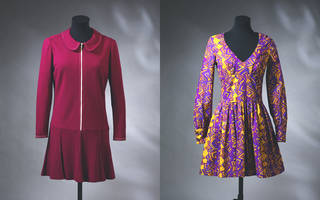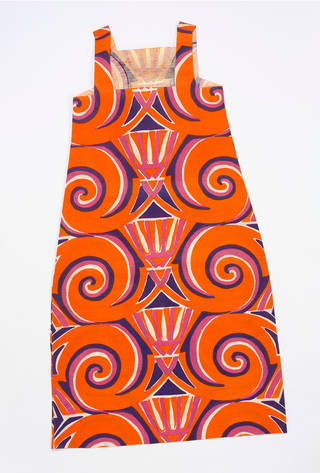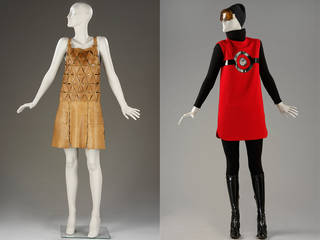Marked by sweeping social change, the 1960s is a decade that still holds a special significance, seeing traditional hierarchies begin to dissolve and make way for the birth of the modern age.
The way people dressed was an obvious sign of shifting attitudes. In the 1960s, many chose, very publicly, to start looking different from the norm. Innovative designers and more informal modes of shopping drew a dividing line between the generations, creating a new market for youth fashion. Our collection tracks the different aspects of this fast-accelerating style revolution, with striking pieces from many of the decade's most influential designers.
I had to go to Sunday School with white gloves, hat and a handbag, just like a miniature mum, in a dress made by her – and exactly the same as hers! I mean, who wanted to do that?! We just wanted to kick against it all.

The invention of youth fashion
In the 1950s, fashion was dominated by the tastes of a wealthy, mature elite. Paris remained the engine of the fashion industry with sophisticated haute couture garments produced in regular collections by the likes of Cristóbal Balenciaga and Hubert de Givenchy (the creator of Audrey Hepburn's iconic black dress in Breakfast at Tiffany's, 1961). But times soon changed. At the dawn of the 1960s, young people's income was at its highest since the end of the Second World War. Increased economic power fuelled a new sense of identity and the need to express it. The fashion industry quickly responded by creating designs for young people that no longer simply copied 'grown up' styles. The Beatniks and the Mods (an abbreviation of 'Modernists') were particularly influential early in the decade. As committed to European-style clothes – characterised by high-impact colour and line – as they were to American soul and R&B music, Mods helped focus the tastes of young people everywhere, and inspired the look of bands like The Who, The Small Faces and The Beatles.

New shops for new fashions
It took a new kind of shop to break the dominance of Paris and to fully ignite the potential of youth fashion. Boutiques were small, self-service shops set up in London by designers who wanted to offer affordable fashions to ordinary young people, offering a very different experience from the often rather formal 'outfitters' and old-style department stores. Being 'on the ground' allowed them to get to know their customer well and to supply their needs quickly. Designers Mary Quant and John Stephen were the pioneers of this new form of retail, having both opened their first stores back in the mid-1950s. They designed and stocked hugely influential fashions that initially nodded to the Mod aesthetic of bright, tailored minimalism.

The reign of the boutique
Within just a few years the boutique scene had exploded. Young people flocked to 'see and be seen' at vibrant new stores, centred on London’s Kings Road and Carnaby Street. These now-iconic shops sold affordable separates suited to a busy, urban lifestyle, allowing their customers to combine items in creative ways. The slim-fitting, brightly coloured outfits produced by London designers became hugely influential throughout the UK, as well as in Europe and America – helping to create the seductive image of 'Swinging London'. The mini-skirt, popularised by Mary Quant, quickly earned its place as the decade's most iconic look, as young women enjoyed the chance to 'dare to bare'. Later in the decade, influential designers included Barbara Hulanicki who, like Quant, focused on fun dresses with daringly short hem lengths, and Marion Foale and Sally Tuffin, notable for their quirky day wear and code-breaking trouser suits for women.
An unnatural obsession

The 1960s fell in love with new, man-made materials, with young designers keen to find new angles on established forms. They exploited the potential of modern plastics and synthetic fibres – Perspex, PVC, polyester, acrylic, nylon, rayon, Spandex, etc. – to create easy-care outfits that were eye-catching and fun. The quest for a truly modern form of clothing was epitomised by the 'paper dress'. Made of cellulose, rayon or polyester, these disposable garments were first created in 1966 as a marketing stunt for an American company that manufactured paper sanitary products. Opportunistic manufacturers in both the US and the UK quickly turned these boldly printed dresses into a novelty must-have that remained popular until 1968.
Clothes for the Space Age

As the decade went on, dress codes, even for the older generation, became increasingly relaxed: tailoring loosened, public figures like Jackie Kennedy began to favour shorter skirts, and fewer people wore accessories like hats and gloves. High-end fashion also embraced the new mood of informality. From the mid-1960s onwards André Courrèges pushed couture tailoring to create audaciously modern clothes. His angular mini-dresses and trouser suits, often produced in what became known as a 'Space Age' white-and-silver colour scheme, were worn with astronaut-style accessories like flat boots, goggles and helmets. He was also unafraid to champion new, cheap materials when they best served his striking designs.
Couture let's go

Pierre Cardin, Emanuel Ungaro and Yves Saint Laurent were among those European designers who successfully translated a couture aesthetic – producing bold, futuristic designs for young people who wanted everyday wear. Cardin, in particular, was excited by new materials including vinyl, silver fabrics and large zips, creating radical forms like his celebrated 'visor' hats. Italian designer Emilio Pucci was also influential. He produced sophisticated clothing for the jet set, but his designs were far from conservative. The first designer to exploit a signature style for high-fashion licensing, Pucci created a range of colourful printed silks. These were used for seemingly endless scarves and ties, as well as the loose-fitting dresses and pyjama suits whose outlines reflected a growing interest in ethnic style. Pucci's busily flamboyant designs prefigured the psychedelic patterns of the drug-fuelled counter culture.

Looking for alternatives
By the late 1960s, style had become quite theatrical. Fashion sanctioned longer hair for both men and women, as well as a flared outline for trousers. Men enjoyed the newly granted freedom to be flamboyant, wearing suits accessorised with bright, bold shirts and high-heeled boots, and, increasingly, as clothes became more unisex, shopped in the same boutiques as women. With war in Vietnam and student uprisings in France, opinion-formers began to disapprove of Pop's materialistic sheen. People moved towards Eastern culture for inspiration. The ideas and mix-and-match aesthetic of California's hippy movement crossed the Atlantic, giving people free rein to 'live different', and to sport clothing from a range of non-Western cultures. Fashion leaders began to sport long, loose and layered outfits, inspired by second-hand, or 'vintage' styles, often from the late nineteenth century and the 1930s. London's Kensington Market became a mecca for young people wanting to create their own alternative look, selling lots of colourful clothing, much of it sourced in India. This new direction was reflected in the fashions of Zandra Rhodes, Foale and Tuffin, and Yves St Laurent, all of whom demonstrated an interest in ethnic textiles.



